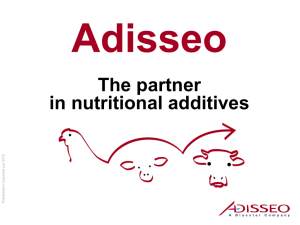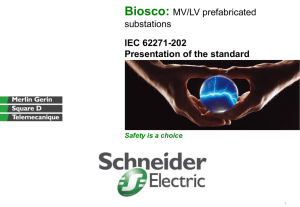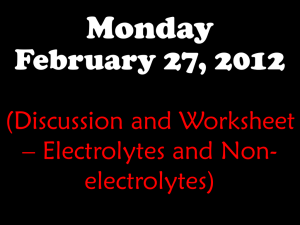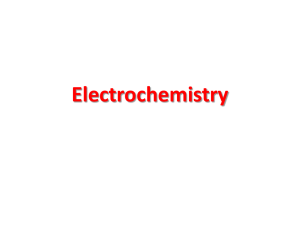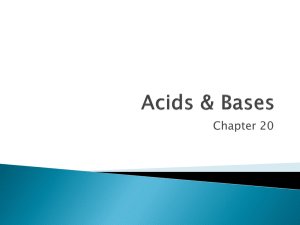Polymers vs. liquids, gels and ionic liquid electrolytes. Any
advertisement
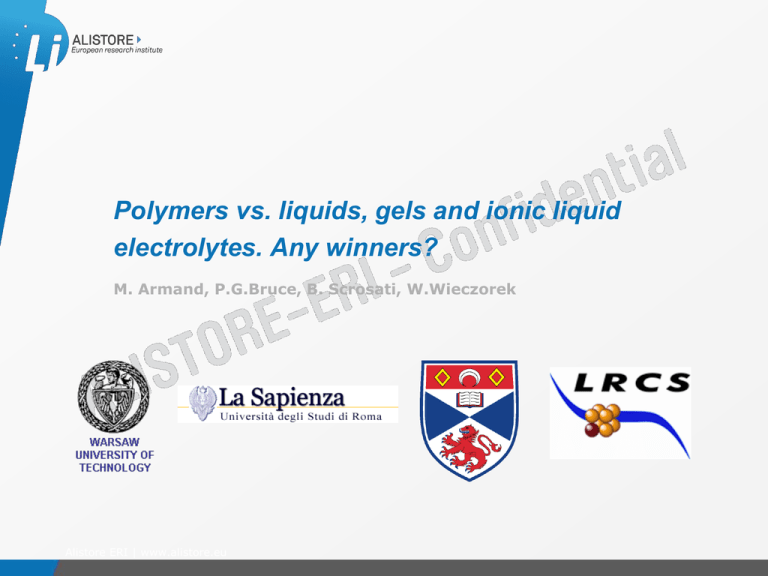
Polymers vs. liquids, gels and ionic liquid electrolytes. Any winners? M. Armand, P.G.Bruce, B. Scrosati, W.Wieczorek Alistore ERI | www.alistore.eu Présentation du 15 octobre 2009 Outline • General status quo of present Li (ion) battery architecture • Introduction to the field of modern electrolytes (concepts, transport mechanisms, improvement strategy) • Role of salt anions • New types of salts • Ionic Liquids • Crystalline Electrolytes (P. Bruce) • Composites (Ceramic, Anion receptors) • Conclusions Alistore ERI | www.alistore.eu Présentation du 15 octobre 2009 Outline • General status quo of present Li (ion) battery architecture • Introduction to the field of modern electrolytes (concepts, transport mechanisms, improvement strategy) • Role of salt anions • New types of salts • Ionic Liquids • Crystalline Electrolytes (P. Bruce) • Composites (Ceramic, Anion receptors) • Conclusions Alistore ERI | www.alistore.eu Présentation du 15 octobre 2009 Strategies for Li Batteries Inorganic: LiFePO4, Li2Fe(Mn)SiO4 Medium capacity “high” voltage Positives: Organic: Li2+xC6O6 Electrolytes: Very large capacity “low” voltage New solutes, polymer (gels) ± ILs Inorganic: Si Very high capacity Cu mandatory / binders? Negatives: Organic dicarboxylates High capacity, 0.8 V Al option, s elec ?? Présentation du 15 octobre 2009 Outline • General status quo of present Li (ion) battery architecture • Introduction to the field of modern electrolytes (concepts, transport mechanisms, improvement strategy) • Role of salt anions • New types of salts • Ionic Liquids • Crystalline Electrolytes (P. Bruce) • Composites (Ceramic, Anion receptors) • Conclusions Alistore ERI | www.alistore.eu Présentation du 15 octobre 2009 Transport mechanisms Liquid electrolytes: transport of solvated species Polymer electrolytes: transport by solvation / desolvation No net displacement of the host matrix Ceramic electrolytes: transport by ion hopping Présentation du 15 octobre 2009 Gels The Donor Number of the polymer repeat units vs. that of the solvent DNsolvent > DNpolymer Direct solvent-cation interaction solvent drag DNPVF DNpolymer > DNsolvent Direct polymer-cation interaction no solvent drag ≈ 0 < DNcarbonates ≈ 15 < DNPEO ≈ 22 Présentation du 15 octobre 2009 Polymer Electrolytes • • Li+ PEO • • • • Electrodonor polymers O,N,S (sufficient donor ability for complexation) Sufficient distance between sites Amorphous Polyethers good candidates Low Tg (flexibility) General classification Polymer Comlexes Poymer Gels Polyelectrolytes (Single Ion Conductors) Copyrights Marek Marcinek Présentation du 15 octobre 2009 Solid Polymer Electrolytes Advantages • non volatility, • no decomposition at the electrodes, • no possibility of leaks, • use of metallic lithium in secondary cells (lithium dendrites growing on the electrode surface would be stopped by the non-porous and solid electrolyte), • lowering the cell price (PEO is cheaper than organic carbonates; it could be used as a binder for electrodes to improve the compatibility of consecutive layers; moreover fabrication of such a cell would be easier – cost), • strengthening of cells thanks to the all-solid-state construction, • shape flexibility, •lowering the cell weight – non-volatile, all-solid-state cells don’t need heavy steel casing, • improved shock resistance, • better overheat and overcharge allowance, • improved safety!!! Présentation du 15 octobre 2009 Solid Polymer Electrolytes Advantages The most important and universal properties of polymeric electrolytes for application in lithium cells: • chemical and mechanical stabilities over a wide temperature range, • electrochemical stability of at least 3-4 V versus a Li electrode; especially important for battery applications • low activation energies for conduction • high cationic transport numbers • good electrode - electrolyte characteristics • ease of sample preparation. Présentation du 15 octobre 2009 Polymeric electrolytes modifications Methods of modification of polymeric electrolytes: - random copolymers - block copolymers - comb-like copolymers - polymer blends - addition of liquid plasticizers - crosslinking (UV, gamma, chemical) - application of plasticizing salts - addition of anion receptors: – soluble Lewis acids – supramolecular receptors - polymer-in-salt materials – well-designed crystalline polymer electrolytes (NEW) – composites with inorganic fillers – ceramic-in-polymers – reversed phase systems (polymer-in-ceramic) (NEW) Présentation du 15 octobre 2009 Electrolyte solvents Generally an ideal electrolyte solvent should meet the following criteria: • be able to dissolve lithium salts to sufficient concentration • its viscosity should be low so fast ion transport can occur within electrolyte • be inert to all cell components especially anode and cathode materials • it should remain liquid in a wide temperature range (low melting and high boiling temperature are desirable) Présentation du 15 octobre 2009 Electrolyte solvents The role of electrolyte is two, or sometimes threefold: •It should provide ionic contact between electrodes allowing to close the circuit when the cell is operational •It should assure electronic and spatial separation of the positive and negative electrode in order to avoid short-circuit and as a result – self discharge of the cell, which in some cases can be very spectacular (as those of failed high power Li-ion cells) •In case of electrochemical systems where electrode components are not the only reactants appearing in the overall cell reaction, the electrolyte is the source (storage) of the remaining ones. Présentation du 15 octobre 2009 (a) Optimization of ion conductivity in mixed solvents: 1.0 M LiClO4 in PC/DME. (b) Dependence of dielectric constant (ε) and fluidity (η-1) on solvent composition. Chemical Reviews, 2004, Vol. 104, No. 10 Alistore ERI | www.alistore.eu Présentation du 15 octobre 2009 Electrolytes additives According to the functions targeted, the numerous chemicals tested as electrolyte additives can be tentatively divided into the following three distinct categories: (1) those used for improving the ion conduction properties in the bulk electrolytes; (2) those used for SEI chemistry modifications; and (3) those used for preventing overcharging of the cells… ….and thus improve SAFETY!!!! Présentation du 15 octobre 2009 Donor Numbers DN for solvents: propensity to give electrons pairs (H of interaction to a reference Lewis acid) CH2Cl2 2 EC,PC, AN THF P(EO) DMF DMSO Py 3 ≈ 15 22 ≈ 27 28 40 MeNO 0 The notion of DN for anions : - + DN(X-) > DN(solvent) Role of - + DN(X-) < DN(solvent) Présentation du 15 octobre 2009 Outline • General status quo of present Li (ion) battery architecture • Introduction to the field of modern electrolytes (concepts, transport mechanisms, improvement strategy) • Role of salt anions • New types of salts • Ionic Liquids • Crystalline Electrolytes (P. Bruce) • Composites (Ceramic, Anion receptors) • Conclusions Alistore ERI | www.alistore.eu Présentation du 15 octobre 2009 Anions – „A Letter to Santa” Properties of the salt used for battery applications are as follows: • it should be able to completely dissolve in the applied solvent at desired concentration and ions should be able to transfer through the solution •anion should be stable towards oxidative decomposition at the cathode • anion should be inert to electrolyte solvent • both anion and cation should be inert towards other cell components • anion should be nontoxic and remains thermally stable at the battery working conditions Présentation du 15 octobre 2009 Anions-Role • Control dissociation and conductivity • Control transport numbers t+ /t• are an important part of SEI build-up at +/- electrodes • Control aluminium corrosion Présentation du 15 octobre 2009 Classic Anions ClO4- BF4- Explosive ! Toxic ! PF6- AsF6- SbF6- Tendency to decompose according to equilibrium: LiBF4 BF3 + <LiF> LiPF6 PF5 + <LiF> Fast reaction above 80°C Destruction of electrolyte and interfaces Présentation du 15 octobre 2009 Conceptual Approach to Anion Design “O” is not a favorable building block: Strong Li—O interactions ion pairing, ≠ ClO4-, BOBIf O present, F or CnF2n+1 is required “N, C” are favorable: Weak interactions Li—N but easy oxidation Présentation du 15 octobre 2009 Diagonally Opposed Interests? Organic chemistry Enhance the activity of anions (SN) + + Electrochemistry Maximize the conductivity - - Ionic processes - - I- = 2,2 Å Li+ design of polyatomic anions Présentation du 15 octobre 2009 Outline • General status quo of present Li (ion) battery architecture • Introduction to the field of modern electrolytes (concepts, transport mechanisms, improvement strategy) • Role of salt anions • New types of salts • Ionic Liquids • Crystalline Electrolytes (P. Bruce) • Composites (Ceramic, Anion receptors) • Conclusions Alistore ERI | www.alistore.eu Présentation du 15 octobre 2009 Hückel anions… Aromaticity 4n + 2 « » electrons X = N, C-CN, CRF, S(O)RF pKA = 10-60 pKA = 10-20 Gain of > 1 eV by resonance See P. Johansson et al Physical Chemistry Chemical Physics, volume 6, issue 5, (2004). Présentation du 15 octobre 2009 Cyanocarbons pKA < -10!! Stronger than 100% sulfuric acid pKA < -3 corrodes glass Présentation du 15 octobre 2009 Hückel anions… DCTA Stable to 3.8 V (La Sapienza, KZ) inexpensive Gives quite fluid ILs Présentation du 15 octobre 2009 Gas Phase Ion Pair Dissociation Energies Ion pair (g) LiTDI < LiPDI LiTDI Li+ (g) + Anion- (g) < LiPDI LiDCTA LiDCTA LiTFSI < LiTFSI < LiPF6 LiPF6 Excellent Theoretical Prediction MP2/6-31G(d) Scheers et al. 2009 Présentation du 15 octobre 2009 Most Stable Lithium Imidazole Configurations 1.93 Å 1.88 Å 1.87 Å 1.92 Å LiTDI LiPDI B3LYP/6-311+G(d) Scheers et al. 2009 Présentation du 15 octobre 2009 LiTDI (2-trifluoromethyl-4,5-dicyanoimidazole lithium salt) Important Benefits •Easy, low-demanding, inexpensive, one-step, high yield syntheses; •Salts are pure, stable in air atmosphere, non-hygroscopic, stable up to 250°C, easy to handle; Présentation du 15 octobre 2009 New salts - Synthetized Examples Présentation du 15 octobre 2009 Exemplary Electrolyte Conductivities (20°C) Présentation du 15 octobre 2009 New Salts - Anodic limit (Pt, ECDMC) Real Chance to be >4V Class Battery Présentation du 15 octobre 2009 Anodic limit (Al, EC-DMC) Real Chance to be >4V Class Battery Présentation du 15 octobre 2009 Cycling LiMn2O4 4.3 V (EC-DMC) Swagelok cell , Al plunger Promising Cycling Performance… Présentation du 15 octobre 2009 Ragone Signature ..as well as Rate Capability and Power/Energy relation Présentation du 15 octobre 2009 Conductivity in PEO SS / PEO20LiX / SS 0.01 1E-3 1E-4 -1 conductivity / cm -1 cooling scan 1E-5 1E-6 DCTA LiDCTA PDI LiPDI TDI LiTDI 1E-7 1E-8 2.5 2.6 2.7 2.8 2.9 3.0 3.1 1000/T / K 3.2 3.3 3.4 3.5 -1 Présentation du 15 octobre 2009 T (°C) 127 111 0.01 10 -2 10 -3 10 -4 10 -5 10 -6 10 -7 97 84 72 60 49 39 30 21 13 P(EO)20LiCF3SO3 (Scm ) 1E-4 1E-5 PEO A PEO2020LiTDI PEO LiPDI PEO 20 B 20 1E-6 2.6 2.8 3.0 1000 / T -1 N PEO20LiBOB/ LiBF4 Hot-Pressing 0.01 T / °C 111,5 84 60,1 39,4 21 2,6 2,7 2,8 2,9 3,0 3,1 3,2 3,3 3,4 3,5 0.01 T / °C 111,5 84 60,1 39,4 21 1000/T (K ) PEO20LiCF3SO3+ ZrO2SA Casting T/°C 111,5 84 60,1 39,4 21 0.01 Conducibilità / Scm -1 1E-3 1E-4 1E-5 1E-4 PEO20 LiDCTA 1E-5 PEO20 LiBF4 1E-8 2.4 2.6 2.8 3.0 3.2 3.4 3.6 -1 -1 1000T / K 1E-7 1E-3 1E-4 1E-5 1E-6 1E-6 1E-7 1E-3 -1 Conducibilità / Scm -1 N + Li 2,5 -1 PEO20LiDCTA Hot-Pressing CN N K 3.2 Conducibilità / Scm NC P(EO)20LiDCTA -1 PEO20LiTDI PEO20LiPDI Hot-Pressing Conductivity S / cm 1E-3 1E-6 PEO20 LiBOB PEO20 LiBF4 1E-8 2.4 2.6 2.8 3.0 3.2 3.4 3.6 -1 -1 1000T / K 1E-7 x: 0% x: 10% 1E-8 2.4 2.6 2.8 3.0 3.2 3.4 3.6 -1 -1 1000T / K Présentation du 15 octobre 2009 Charge profile 4.3 V cut-off, Al collector Présentation du 15 octobre 2009 Anodic stability Li / PEO20LiX / Super P current / mA/cm 2 0.20 DCTA LiDCTA PDI LiPDI TDI LiTDI Anodic breakdown voltage vs. Li 0.15 0.10 0.05 P(EO)20LiDCTA 3.6V P(EO)20LiPDI 4.0V P(EO)20LiTDI 4.0V 0.00 3.0 3.5 4.0 4.5 5.0 5.5 6.0 6.5 Potential / V Présentation du 15 octobre 2009 Interphase resistance - PEO Li / PEO20LiX / Li LiDCTA -100 -60 2h 7h 2d 7d -100 -40 -20 -80 LiTDI 4.5h 1d 5d 12d -60 -40 -20 0 0 0 40 80 120 160 200 0 40 80 Zreal / Ohm 2h 7h 2d 7d -80 -60 120 160 Zreal / Ohm LiPDI -100 Zimm / Ohm Zimm / Ohm -80 4.5h 1d 5d 12d Zimm / Ohm 2h 7h 2d 7d 4.5h 1d 5d 12d -40 -20 0 0 40 80 120 160 200 Zreal / Ohm Présentation du 15 octobre 2009 200 Cycling behaviour Présentation du 15 octobre 2009 % of capacity at C/20 Rate capability (PEO) Présentation du 15 octobre 2009 New imidazole-derived salts • Easy, low-demanding, inexpensive, one-step, high yield syntheses; • Salts are pure, stable in air atmosphere, non-hygroscopic, stable up to 250°C, easy to handle; • 20°C ionic conductivity exceeds: • 10-3 S∙cm-1 in PC, 10-4 S∙cm-1 in PEGDME500 • 10-6 S∙cm-1 in PEO (10-4 S∙cm-1 at 50°C) • 6 mS∙cm-1 in EC:DMC • T+ at ionic conductivity maximum reaches: • 0.45 in PC, 0.40 in EC-DMC, 0.25 in PEGDME500 (but overall max 0.62); • Stable over time against Li; • Stable up to 4.4 V vs. Li against metallic lithium anode; • Stable up to 5.0 V vs. Li against aluminum; • Much smaller association rate than commercially available salts; Présentation du 15 octobre 2009 Outline • General status quo of present Li (ion) battery architecture • Introduction to the field of modern electrolytes (concepts, transport mechanisms, improvement strategy) • Role of salt anions • New types of salts • Ionic Liquids • Crystalline Electrolytes (P. Bruce) • Composites (Ceramic, Anion receptors) • Conclusions Alistore ERI | www.alistore.eu Présentation du 15 octobre 2009 Ionic Liquids (IL) 1/3 Typical cations used in ionic liquids: 1) Imidazole cation 2) Alkylpyridine cation 3) Dialkylpyrrole cation Ionic liquid with lithium cation example Présentation du 15 octobre 2009 The basic IL V = 142.5 Å3 V = 107.3 Å3 V = 88.4 Å3 Présentation du 15 octobre 2009 First Alkali metal IL? K(CF3SO2NSO2F) 99°C Eutectics, re-investigation of “polymer in salt” (Angell) Présentation du 15 octobre 2009 Outline • General status quo of present Li (ion) battery architecture • Introduction to the field of modern electrolytes (concepts, transport mechanisms, improvement strategy) • Role of salt anions • New types of salts • Ionic Liquids • Crystalline Electrolytes (P. Bruce) • Composites (Ceramic, Anion receptors) • Conclusions Alistore ERI | www.alistore.eu Présentation du 15 octobre 2009 Crystalline Solid Polymer Electrolytes 1/2 T/ °C -4.0 60 50 40 3.0 3.1 3.2 30 20 1 log(/S cm ) -4.5 -5.0 -5.5 -6.0 -6.5 -7.0 -7.5 -1 1000 T Fig.1 The structure of PEO6:LiAsF6. Left, view of the structure showing rows of Li+ ions perpendicular to the page. Right, view of the structure showing the relative position of the chains and their conformation (hydrogens not shown). Thin lines indicate coordination around the Li+ cation. 3.3 /K 1 Fig.2 Conductivity of crystalline polymer electrolytes. Red - PEO6:LiAsF6; green PEO6:Li(AsF6)0.9(SbF6)0.1; magenta - PEO6:(LiSbF6)0.99(Li2SiF6)0.01; blue PEO6:(LiAsF6)0.95(LiTFSI) 0.05; black - (PEO0.75G40.25)6:LiPF6. G4 – tetraglyme, CH3O(CH2CH2O)4CH3. Présentation du 15 octobre 2009 3.4 Crystalline Solid Polymer Electrolytes 2/2 Fig.3 The structure of PEO8:NaAsF6. Left, view of the structure showing rows of Na+ ions perpendicular to the page. Right, view of the structure showing the relative position of the chains and their conformation (hydrogens not shown). Thin lines indicate coordination around the Na+ cations. Présentation du 15 octobre 2009 Outline • General status quo of present Li (ion) battery architecture • Introduction to the field of modern electrolytes (concepts, transport mechanisms, improvement strategy) • Role of salt anions • New types of salts • Ionic Liquids • Crystalline Electrolytes (P. Bruce) • Composites (Ceramic, Anion receptors, Ceramic „sponges”) • Conclusions Alistore ERI | www.alistore.eu Présentation du 15 octobre 2009 PEO-based electrolytes transference number Lithium transference numbers for (PEO)20LiClO4 based composite electrolytes containing 10% by weight of inorganic filler additives Type of the electrolyte Type of the filler Temperature/oC Lithium transference number (PEO)20LiClO4 Filler free sample 40 0.31 (PEO)20LiClO4 Al2O3 40 0.61 (PEO)20LiClO4 Al2O3 (1% ASG) 40 0.66 (PEO)20LiClO4 Al2O3 (4% ASG) 40 0.72 (PEO)20LiClO4 Al2O3 (8% ASG) 40 0.77 (PEO)20LiBF4 0 70 0.32 (PEO)20LiBF4 Surface modified ZrO2 70 0.81 Présentation du 15 octobre 2009 Lithium transference numbers for PEO-LiX-Calix-6-pyrrole electrolytes Type of the electrolyte Molar fraction of calix- Temperature/oC 6-pyrrole Lithium transference number (PEO)20LiI 0 70 0.25 (PEO)20LiI 0.125 70 0.56 (PEO)20LiAsF6 0 75 0.44 (PEO)20LiAsF6 0.5 75 0.84 (PEO)20LiBF4 0 70 0.32 (PEO)20LiBF4 0.125 70 0.78 (PEO)20LiBF4 0.25 70 0.81 (PEO)20LiBF4 0.5 70 0.85 (PEO)100LiBF4 0.25 70 0.95 (PEO)100LiBF4 1 70 0.92 (PEO)20LiCF3SO3 0 75 0.45 (PEO)20LiCF3SO3 0.125 75 0.68 Alistore ERI | www.alistore.eu Présentation du 15 octobre 2009 How does it (probably) work? 1) KI>Kcal>KT KI-ion pairs formation constant 2) KI>KT>Kcal KT-ionic tiplets formation Kcal-calix-anion complex constant 3) Kcal>KI>KT O O O O O ClO4 Calix - Li+ ClO4- ClO4- Li+ Calix Li+ Calix O Présentation du 15 octobre 2009 PEO-based electrolytes additives stability Cyclic voltammograms of LiTf:PEO20 membranes with and without C6P and SiO2 additives at (a)75˚C and (b)90˚C over potential range of 0-5.0V using SS/PE/SS cell configuration H. Mazor, D. Golodnitsky, E. Peled, W. Wieczorek, B. Scrosati, J.Power Sources, 178 (2008) 736743 Présentation du 15 octobre 2009 New Types of Ceramic Composites 1/2 – Concept and Structure Inhibition of crystallization Présentation du 15 octobre 2009 New Types of Ceramic Composites 2/2 – Preliminary/First!!! Electrochemical Testing Présentation du 15 octobre 2009 Outline • General status quo of present Li (ion) battery architecture • Introduction to the field of modern electrolytes (concepts, transport mechanisms, improvement strategy) • Role of salt anions • New types of salts • Ionic Liquids • Crystalline Electrolytes (P. Bruce) • Composites (Ceramic, Anion receptors) • Conclusions Alistore ERI | www.alistore.eu Présentation du 15 octobre 2009 Conclusions • Anion design is one (most?) of the important aspect of electrolyte improvement • Hückel anions offer a cheap alternative and are covalent (i.e. easy to handle, dry…)! • CF3 (C2F5) dicyano imidazoles are stable @ 4.6 V and do not corrode aluminum • Many tools but still a lot of steps toward better real life systems Role of positive input/collaboration from the industry! Présentation du 15 octobre 2009 Acknowledgements The following scientists greatly contributed to the preparation of this report: From Warsaw University of Technology: Marek Marcinek Leszek Niedzicki Jarosław Syzdek From University of St. Andrews: Yuri Andreev From Chalmers University: Per Jacobsson Patrik Johansson Johan Scheers Présentation du 15 octobre 2009
